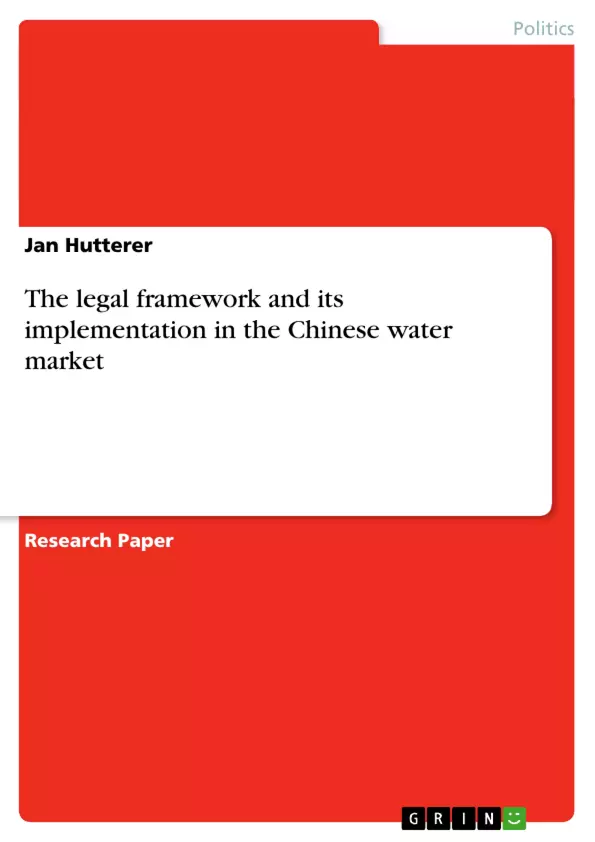Worldwide the hidden costs of Chinas rapid transformation have caused deep concerns. In recent years the cases of water shortages, pollution and flood/drought damages steadily increased in numbers. This development is caused by both a large population and a rapidly developing economy. Although China significantly improved its water and wastewater infrastructure, its water shortage problem is worsening year by year. The Chinese government tries to counter this misbalance and insistently pursues an environmentally sustainable development policy. Its countermeasures include management model reforms, Private-Sector-Participation (PSP) projects and the support of new technology development and application. According to the 11th Five-Year-Plan, more than 140 billion Euros will be spent on environmental projects and campaigns before 2010. These reforms have unleashed a wave of optimism in China‟s water market and created great market opportunities for investors. Significant amounts of new water infrastructures are to be built, and the operation and maintenance of all existing and newly built municipal water and wastewater treatment plants have been or will be transferred to authorized enterprises. However, these opportunities are not without risk. Investors are particularly skeptical about the development of the legal environment. The contradiction of theory and practice is striking. On one hand China‟s legal framework for environmental protection appears extensive and strict. On the other hand a violation of these regulations is seldom sanctioned. This paper tries to analyze this ambivalent picture. It examines the key regulations of the Chinese water sector, illustrates the interdependencies between the relevant authorities and analyzes their implications on investment opportunities for foreign enterprises.
Inhaltsverzeichnis (Table of Contents)
- Introduction
- Factors influencing the reform policy
- Environmental determinants
- Social determinants.
- Economical determinants
- Regulatory environment
- Legislative authorities
- Important laws and regulations
- National standards and principles
- Implementation of laws and regulations.......
- Administrative authorities ...........
- Horizontal and vertical ties
- Policy and investment implications..
- Public investments.....
- Foreign participation.
- Remaining challenges
- Conclusion.....
Zielsetzung und Themenschwerpunkte (Objectives and Key Themes)
This paper aims to analyze the legal environment surrounding China's water market, exploring the interplay between regulations, implementation, and investment opportunities for foreign enterprises. It examines the key regulations of the Chinese water sector, illustrates the interdependencies between the relevant authorities, and analyzes their implications on investment opportunities for foreign enterprises.
- China's water scarcity and the challenges of sustainable water management
- The legal framework for environmental protection in China
- The implementation of water-related laws and regulations
- The role of administrative authorities in water management
- Investment opportunities and risks in China's water market
Zusammenfassung der Kapitel (Chapter Summaries)
- Introduction: This chapter discusses the growing challenges of water scarcity and pollution in China, highlighting the increasing need for sustainable water management. It emphasizes the importance of legal frameworks and their impact on investment opportunities.
- Factors influencing the reform policy: This chapter explores the environmental, social, and economic factors driving water management reform in China. It delves into the country's water resource availability, geographical constraints, and the environmental consequences of rapid economic development.
- Regulatory environment: This chapter provides an overview of the legal framework governing China's water sector. It examines key laws, regulations, and national standards related to water resource management and environmental protection.
- Implementation of laws and regulations: This chapter analyzes the implementation of water-related regulations, focusing on the roles of administrative authorities and the interdependencies between different levels of government.
- Policy and investment implications: This chapter examines the implications of China's water management policies for investment opportunities. It discusses public investments, foreign participation, and the challenges facing investors in this sector.
Schlüsselwörter (Keywords)
China, water scarcity, water management, legal framework, environmental protection, regulations, implementation, investment opportunities, foreign enterprises, administrative authorities, public investments, private sector participation, sustainable development.
- Citation du texte
- Jan Hutterer (Auteur), 2008, The legal framework and its implementation in the Chinese water market, Munich, GRIN Verlag, https://www.grin.com/document/88255



